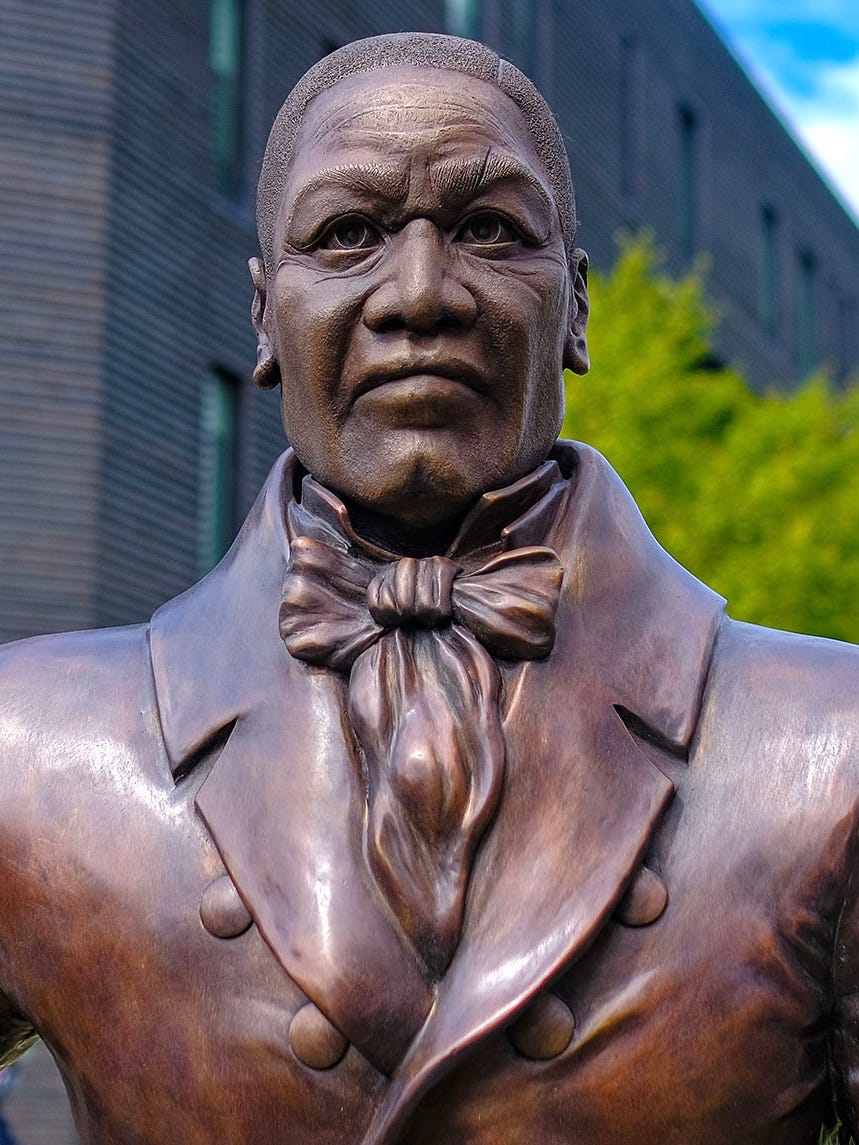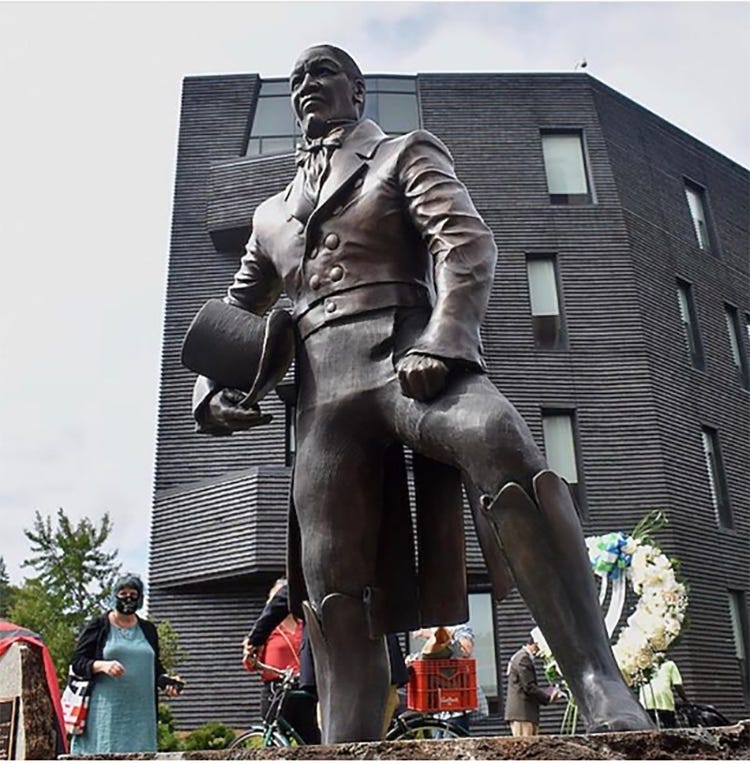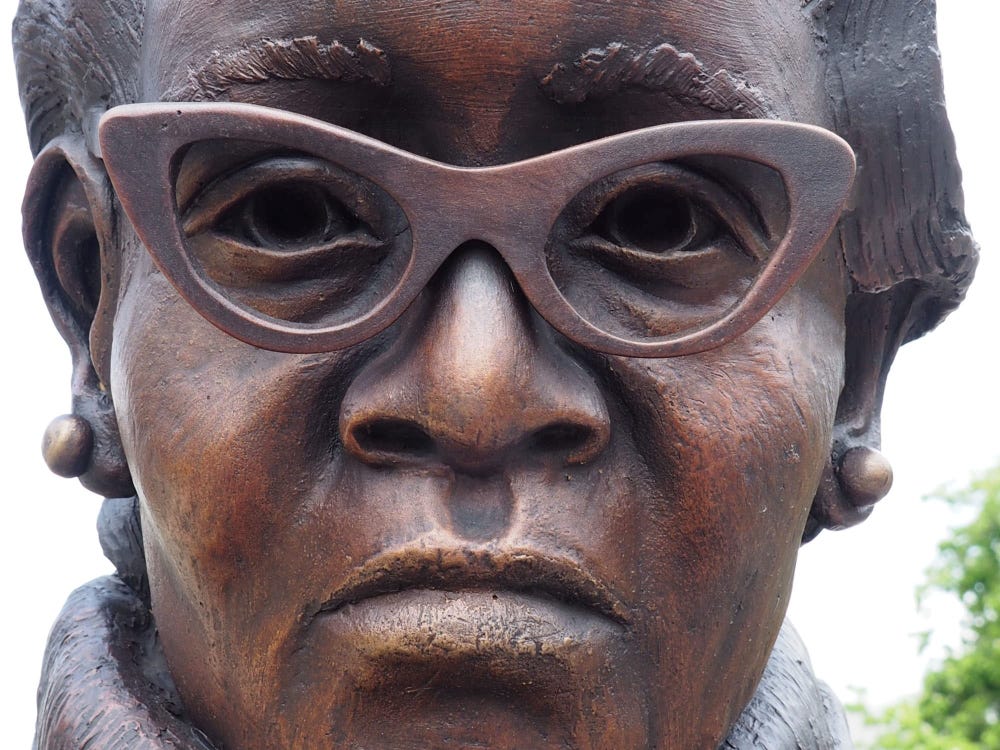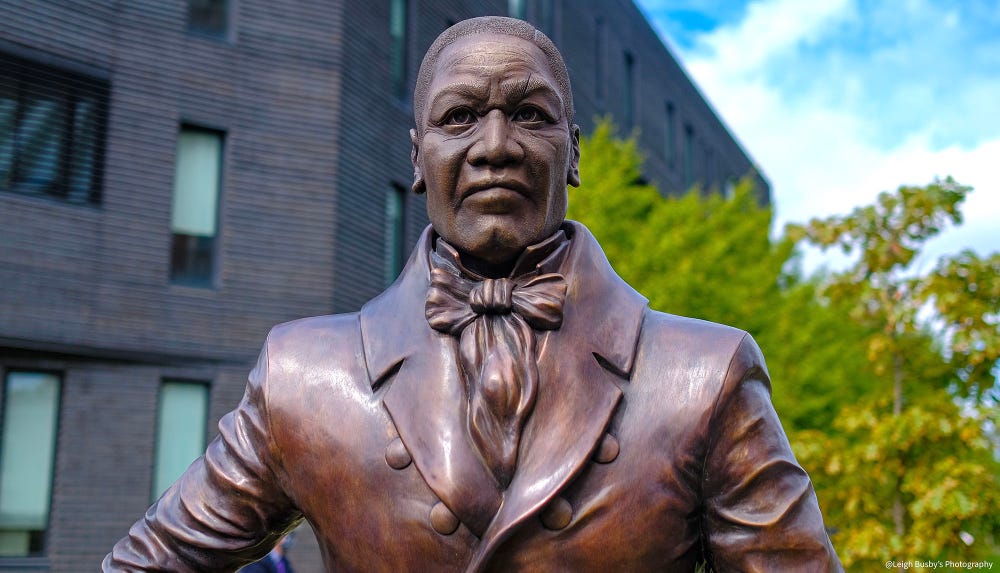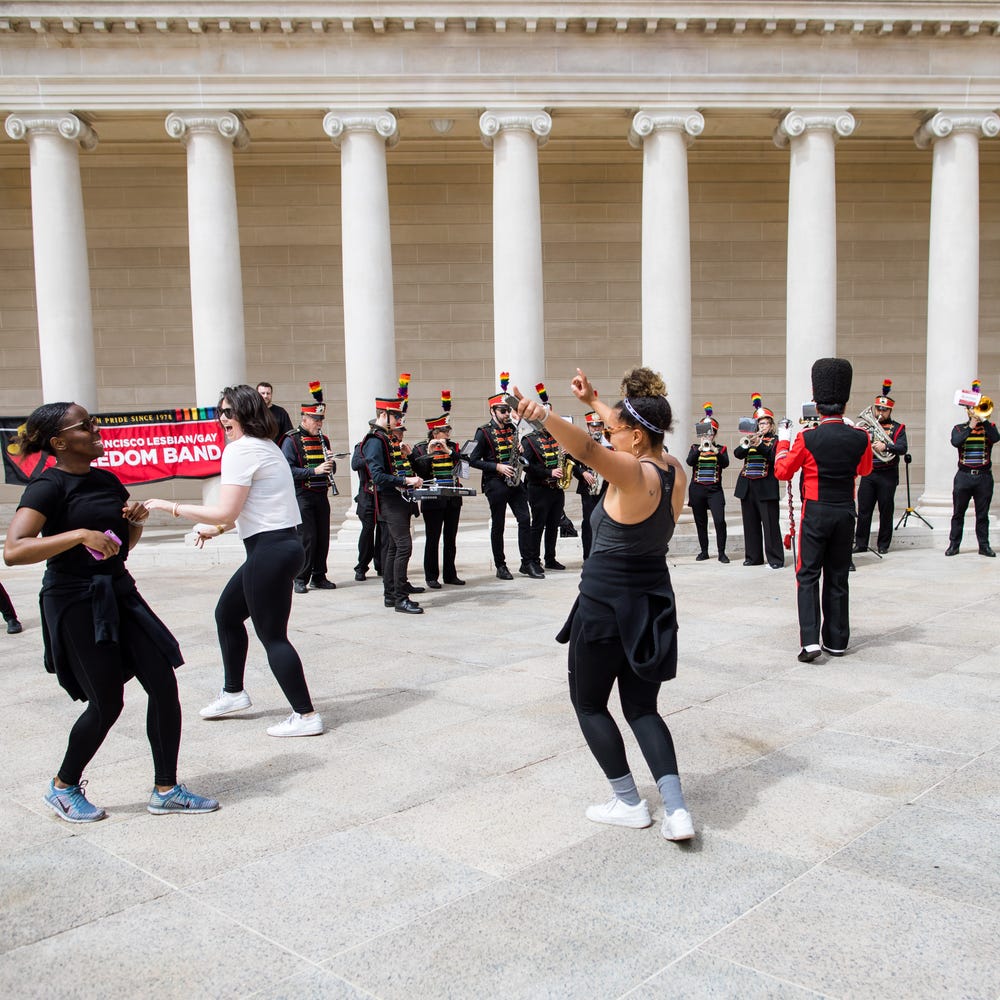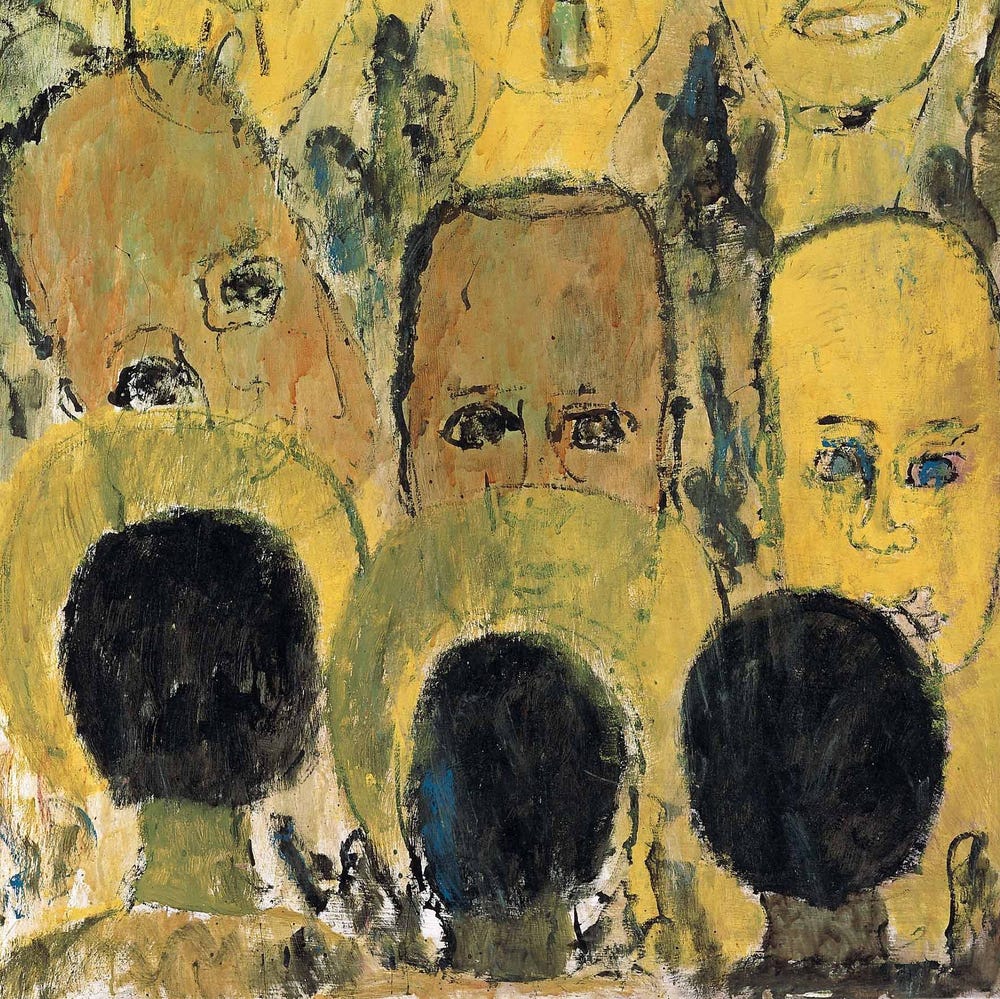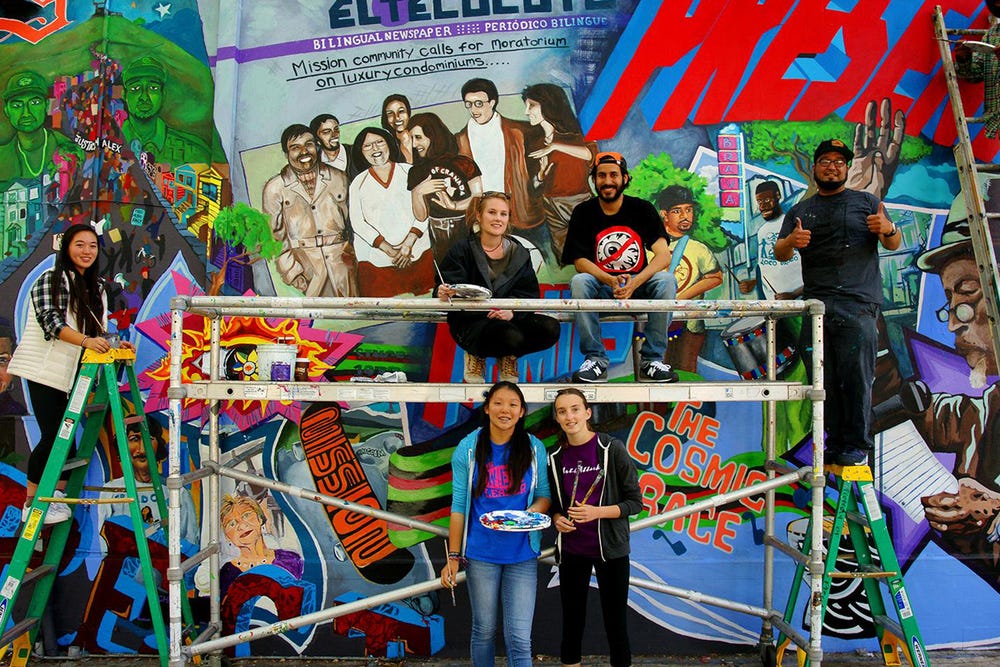Local Voices S3E4 - Dana King
Air Date: 5.10.21
Length: 24:28
Music: AWEN - Your Voice Produced by: Supervillain
SPEAKERS
Francesca D'Alessio, Dana King
Francesca 00:03
Sculpture is an artistic form of expression that transforms materials into three-dimensional masterpieces. Through the artist’s hands, life is brought into inanimate objects giving form, shape, and movement. These pieces have been crucial markers of historical periods revealing our shared values and evolving culture. Many times they've been used to portray historical figures, and in a lot of cases have been used as a means of asserting status. Sculpture inhabits space and space is power, says classical figures sculptor Dana King. The hands behind the sculptures are not only shaping precious materials, but they are shaping the narrative of our history. King, a former news anchor journalist, has chosen bronze as her preferred medium for storytelling. With each new creation, King works to change the narrative and use sculpture as a means for community healing.
Francesca 01:21
All right, well, Dana, I love you. I'm one of your biggest fans. And I'm so excited to have this conversation.
Dana King 01:28
I'm very excited too, I remember the first time I saw you at the de Young hosting a conversation with Fredrika Newton. And I just I don't know, I was just impressed with your energy and then to meet you and see that that wasn't a put-on that wasn't for show. That's who you are. You just have so much energy. I love it. I can feel it.
Francesca 01:50
Well, I love your artistic energy. I mean, your studio is incredible. It's beautiful. I mean, look, I can't help but look at all the details behind you. So my first question for you is, when did you know that you were an artist?
Dana King 02:04
Well, I think there were several phases of it. I mean, as a kid, I certainly drew all the time. I remember you're gonna laugh, those matchbooks that would have the Bulldog in it, and say, Can you draw this and I would sit and draw. And I'd be like, Mom, look, I can draw this Can I go to art school? And I was little and so I've always done something artistic. And I remember in second grade, I had a teacher who told me that, basically, you know, I had no talent, my art was not good.
Dana King 02:39
And you're what 7, 8 or something. And I know there are so many people that that happened to and, and for them, they just stopped being stubborn. And you know, think Canada's I am I just kept going. I'm like, Well, whatever,
Francesca 02:55
When I love your stubbornness, because here we are, and you've made some of my favorite artists.
Dana King 03:01
So actually, I stopped drawing, you know, I've had I'm on my third career now, right. And my second one was as a broadcast journalist, and that satisfied me creatively for a long time. I did that for 25 years. And, you know, you're marrying sound and pictures and concept and writing. And so that was a great creative outlet for me. But I was in Kosovo, it took me a couple of days, I'm kind of embarrassed to say that I didn't, I realized that I didn't see any women. And when I finally asked, like, Where are the women, because the men were in the markets, and they were out drinking tea and playing board games, and I found the women in the fields, and they were literal workhorses. And so when I came home, I didn't want to write about it anymore, and I couldn't really let it go. And so I went to the art store I bought some paintbrushes, and canvas and paint and I started to paint. And I created a series of Muslim women. And that's what got me back to art school. I entered art school with that series of paintings. And it's been this journey ever since I was like 48 years old when I went back to art school.
Francesca 04:24
Good for you. Wow. You know, I was gonna ask 25 years as a journalist, because artists are so emotional, so how did you do that to be objective for 25 years? Because you're a good journalist.
Dana King 04:36
Well, thank you. I mean, it's training you to fashion your life in that way. And that was my job was to be as objective as possible, you know, covered a lot of really challenging stories, and I've been all over the world and I'm super grateful for that career. Because it dropped me in places that I would never, ever have an opportunity to spend any time in like Iraq and Afghanistan, Kosovo and the Middle East and Africa, Rwanda and Ghana. And I mean, I just had that kind of career and, and it taught me to be quiet and to listen and to be observant.
Francesca 05:18
It's so powerful because your art is sort of your life experience that has exploded, you know, as your objective for all those years, I feel like now it's exploded into creativity and emotion. And, you know, all of those different experiences are coming out now through your art. It's so beautiful.
Dana King 05:35
Thank you. I mean, I love people. And research is foundational to my work. So I love history. So it's really like an extension of my journalism because I create black bodies and bronze and they're historical figures. And there's a narrative that goes with it. In broadcast journalism my work lasted two minutes. And once it aired, it was kind of like gone. But working in bronze and telling those stories.
Those stories will last for as long as the bronze lasts.
Francesca 06:11
Bronze is not easy. I mean, you have to be talented. You have to know the medium. Where did you start? And what like what was your interest in bronze?
Dana King 06:19
Well, I didn't, I didn't have an interest in bronze. I mean, I was just I was creating pieces, and then making a mold of them. I didn't make them all but creative. Artists made the molds for me. And, and they will pour them in bronze and then paint them with oil paint. So Mildred Howard, and most incredible artists, yes,
Francesca 06:42
I love Mildred Howard.
Dana King 06:44
She's a phenomenon and I credit my public art to her. So I got a call one day from a group of people that wanted a sculpture and they wanted a bust. And I felt like I could do that. And I found out that Mildred recommended me for that. But bronze is amazing. It's an amazing metal. And so I just finished Huey here who is going to go up in West Oakland at Mandela Parkway, and what used to be Ninth Street, which is now Huey P. Newton way. And so he just went to the foundry on Monday, and he'll be made into bronze over the next five weeks or so
Francesca 07:27
You're working in this material that is so hard to navigate and work with. And then you have the likeness of the human. It's amazing. There are so many different layers to this world.
Dana King 07:37
And the bronze informs its aspect of reality. And so I was telling who is widow Fredrika that. So she's been with me since I started him in clay, I keep pointing in my studio, because he's still here in clay right, right to the left of me. And I said, wait till he's in bronze, I keep telling you that wait till he's in bronze, you'll see it'll be so different. And even from the plaster to the bronze, because it because it's skin tone, and he's gonna be a beautiful brown, golden brown man and, and he'll be warmed by the sun, and you can touch bronze, and you can't hurt it. And, and so I keep telling her that you're gonna just be so amazed when he comes to life back in bronze.
Francesca 08:23
You must have such an intimate relationship with him at this point. I mean, you know, every wrinkle he's ever had.
Dana King 08:30
So Fredrika, bless her heart, she spent a lot of time here. And we would talk about him and she would tell me stories that were funny or heartbreaking. And she will put her hands on him, because she has that, that that memory of how his face felt to her when she touched it. And I've never worked on someone who so closely I knew the person that I was trying to recreate. And it was an amazing experience.
Francesca 09:03
So from when you started to net-like how long is this process take?
Dana King 09:09
Well, it usually I'm they gave me a lot of time and I'm super grateful. There have been easily seven iterations of Huey. So I think I got the green light in July, June, or July I don't even remember and started right in on him. I have to tell you a really amazing story. So I never tell anybody about what I'm doing until there's a contract. So I need to tell my family and we live here in community in Oakland. It's compound and my grandson comes in. He's four every morning comes into grandma Gemma's bedroom, and he gets in bed and we snuggle up and he said, Grandma, there is a panther in your studio. And I said “Why?” He said yeah, “It's a Black Panther Grandma, ” and he came in and set it to me and I grabbed my phone, I text my daughter go, is he watching the Black Panther on his little iPad or whatever I'm like, because when talking about the Panther, and she's like, I don't know what you're talking about. I don't even know where his iPad is. And, and he has been that channeler of the Panthers since they started. I don't know where he got that from. And so Huey has been in here, he has guided this as much as Fredrika has guided it.
Francesca 10:35
I mean, the likeness of him in the clay is unbelievable. I mean, I look at him, right, because to him, it's him, there's no question. You know, it's interesting to follow you and Freddy on this journey of how you got to this piece, because, you know, to this point, because this is exactly what is meant to be displayed.
Dana King 10:55
Fredrika and I talked about what she hoped people would feel when they saw him. And she wanted people to feel proud and connect to the truth of the Panthers. And, and the hard work. And the love that he had for community for black people.
Francesca 11:12
Is there going to be any sort of writing or any, you know, educational tools with the sculpture?
Dana King 11:18
There'll be a plaque that goes along with it. But Fredrika is working with the parks. The federal park system, because there are so many sites around the Bay Area, Richmond, Oakland, San Francisco, where the Panthers had rallies and supported, you know, the party, and they're there in conversation about the parks park system, taking that over and doing like a Rosie the Riveter kind of thing because that's got several different sites. And that would be, that would be everything, if that happened.
Fran 12:00
It's so brave to create public art for a public space. Because you're infiltrating people's day-to-day lives. You know, you're a part of everyone's running for the bus. And, you know, just the sort of mundane things that you've now elevated, you've made educational, you've made beautiful, you've, you know,
Dana King 12:17
It's amazing, and they might not necessarily know, it's you, but you've had this impact on them. That's the lesson for me is that we all are experiencing our own issues and our own life in the way it's coming at us. But if we can connect over a piece of art, then it's worth the pack in that terror away, right? If someone can if we can if we can have a conversation? And maybe not even in the same language? You know, I mean. . .
Francesca 12:48
Right. That's what I was thinking, you know, art is one of those things, there are no words art, music, you know, sort of this universal language.
Dana King 12:55
That's it for me is that is a point of connection. And I suppose it's a non-threatening point of connection because you're going to experience a differently than maybe even the intention behind it, right? And it opens up this whole new avenue in which to see a piece and I'm always really curious about how people see are what their perception of it is, and what makes them feel and, and how it makes them feel. Right. Because there's, there's always learning in there.
Francesca 13:31
And it's different for everybody. I mean, that's the beauty of it, you know, we bring ourselves to viewing the piece. So, no, you're right. I mean, under the vein of connection, putting it out in a public space, you have a larger ripple effect, more people will see it more people connect over it. Especially a figure like Huey, who in his lifetime connected people. I mean, I think there's going to be huge ripple effects of goodness coming out of the sculpture. It's in the right place at the right time at the right, you know, there's just something so serendipitous,
Dana King 14:02
You're absolutely right. I mean, it, you know, people deserve to see themselves in this artwork. And they and because it's, it's the collective memory and still successfully. Exactly. And, and, but for me, it's a, on a broader scale than the individual pieces. It really helps inform the ways that people see black people. And that's so important today and it and it's not just black people, it is the representation of the art itself and the community that it represents. It's it gives people a way to in a non-threatening way to come together. Right. You know, like who is this person who's been immortalized? In metal, I need to know more about that. And what we have available to us in terms of speaking on behalf of others is the news. And I'm granted, you know, we could all do the work of researching, but we don't, right, we're gonna take the most available thing to us. So I'd rather it be art than a TV report, you know, we need more of it, we just need more of it out in public spaces. Because, you know, not everybody can get to the museum. You know, not everybody can afford the museum, their kids that have never been to the beach who live here in Oakland, right? So I want them to see themselves. And I especially want kids to see art that looks like their mom or dad or grandparent or uncle or aunt, I mean, because then they start to feel important. But that's art. That's art. Right? Um, and I just, I wish it informed more people's lives.
Francesca 16:11
The question I always ask artists is how do you know when the piece is finished? And I feel like this is a very interesting answer for you. Because yours are very figurative. You know, so yeah. So anyway, I won't project what I think but yeah, how do you know when a piece is finished?
Dana King 16:27
There's that moment? Well, it's a long moment when I start a sculpture, like, I am like, how am I going to get there? I have no idea how I'm going to get there. I'm just going to keep going until I get there. And hopefully, I mean, it comes in I mean, I'm always on deadline, which I thrive. I love being on deadline. But um, but you know, there is that process of, and it's not a process. It's an emotional, spiritual visual process that it takes before I get to that point.
Francesca 17:18
So, do you ever work in any other mediums besides bronze? Have you ever tried stone or any other it's always been bronze for you?
Dana King 17:27
So when you work in stone, it's reductive you're taking away. Right? My process is that I build up. And I can take away and build up and take away but you know, a piece of carrera marble is its own beautiful, life-giving organism right? I don't want to practice on that. any of that. Right? So um, no, I don't know, I feel really comfortable in this medium, I still have a lot to learn. You know, I came very late in life. And so I look forward to the day when I can experiment more, but I feel like I have a mission to create these narratives these black bodies in bronze.
Francesca 18:24
So then what is next? What else does the future hold?
Dana King 18:28
Super excited about this. So, I love when I get to create somebody that deserves to be known worldwide, right? Well, they all do. But um, so I was awarded a commission by the San Francisco Giants and development at Mission raw, which is right next to the giant stadium to create a sculpture of the first woman, black woman to play Major League Baseball. Oh my god. I never heard of her. Her name is Tony stone. And she played for the Negro Leagues. She took over for Hank Aaron. at second base for the Indianapolis clowns. She played on four teams, including the San Francisco sea lions, and so two other women came after her. But at the end of 2020, last year, the Major League Baseball decided to accept the Negro Leagues, statistics and the teams and the players and also that so now she is officially the first woman to play Major League Baseball in this country. Right. I mean, she was the first woman to play Major League Baseball in the Negro Leagues. I haven't started on her yet. So I think she'll go in and like, third-quarter 3. I don't really have the timeline yet, but it'll be the next thing I work on. I'll start on her. Probably Am September the beauty of sculpture for me is that sculpture and habit space. And space is power, the more space you have, the more powerful you are. And, and there are a lot of images of African descendants out in the world for us to see. And so it's really, it's the actual art form that I'm attracted to as much as the narrative of, of the individuals that I want to see out in the world because I want people to come up on this art. Because it's so surprising because we're not out there in the world. And, and our memories, our histories, deserve to be out there, because we're such an integral part of, of the way this country has been built, and the way that it moves. And, and, and to be able to come upon a piece out in public, it's kind of like, for how I feel about it, seeing an African narrative out there in the world. It's just it's, it's like shocking, in such a good way. It's, it's so powerful. Because not everybody can get to a museum and not everybody has the art in their home, and especially sculpture, right? The size of it really dictates the power of that person. Right? That's why I like to build bigger than life-size, but not so big that it's, you know, it's, it's not realistic. I heard these numbers that the Smithsonian keeps track of all the art in the United States. And boy, I hope I'm not wrong about this. But there are roughly 750 pieces out in this country that is ethnic oriented, I think that's the category and, and of those, the percentage of, of ethnic artists that created them is minuscule. So it's about the art. It's about the size, it's about the space it takes up. It's also about who did it, who created it. I think it's important for me, well, I don't think I know it's important for me as a black woman to create black art.
Francesca 23:03
"These stories will last for as long as the bronze lasts." And in today's interview, the wise words of Dana King will also live on. Artists like Dana have taken the great responsibility to create and sculpt new memories and shared experiences for our future generations. Public Art is powerful. Public Art tells the stories of our past, what we value today, and what we will be remembered for tomorrow. Next Monday, join me as we speak with San Francisco legend, Susan Cervantes, who is the founder and director of Precita Eyes Muralist, located right here in the heart of the Mission District, and one of the few community mural art centers in the United States. I'm Francesca D’Alessio, and I oversee the public program's initiatives at the fine arts museums of San Francisco. And I'm your host for this series. Please visit our website deyoung.famsf.org\programs\localvoices to find transcripts for this episode, and be sure to subscribe to the museums' email newsletters to learn all about what's going on here at the de Young.
